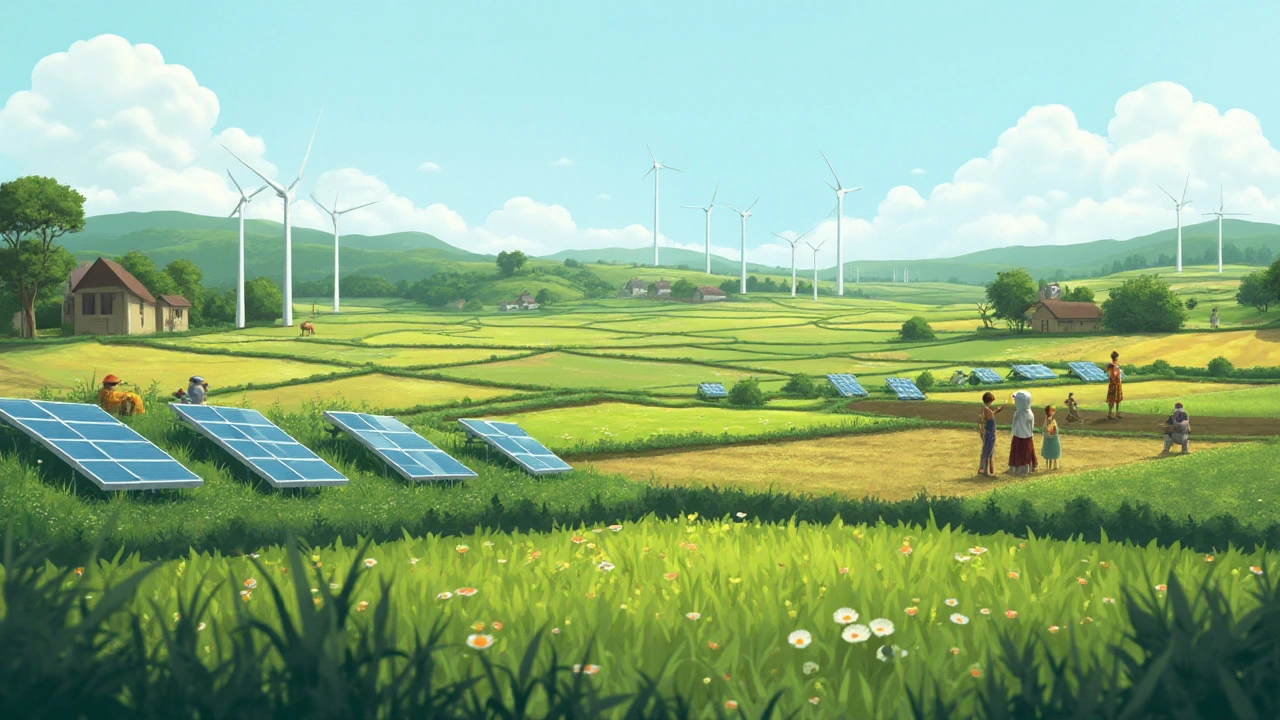
- Created by: Lydia Carmichael
- Completed on: 27 Jan 2025
- Categories: Environment
In a world increasingly attuned to the health of our environment, understanding the roles of various environmental groups is more important than ever. These groups are vital to efforts aimed at protecting our planet, from breathing life back into endangered ecosystems to influencing policy changes at the highest levels of government.
There are three major categories of ecological groups, each with unique missions and approaches. From conservation organizations focusing on the preservation of wildlife and natural habitats, to advocacy groups championing sustainable living, and policy-focused entities striving to implement legislative changes for the environment, there is a diverse range of efforts happening across the globe.
This article explores what these groups entail and how they contribute to environmental well-being. Whether you're looking to participate actively or just wish to understand the landscape better, knowing these categories helps guide more eco-conscious choices. Dive in to discover how these three ecological groups are making a difference.
- Introduction to Environmental Groups
- Conservation Organizations
- Sustainability Advocates
- Policy-Focused Groups
- Impact on Global Ecology
- How to Support and Get Involved
Introduction to Environmental Groups
Environmental groups have been at the forefront of advocating for the planet's health and sustainability for decades. These diverse organizations operate under the common goal of promoting environmental protection and stewardship. What distinguishes them is their varied approaches and focus areas, which encompass everything from grassroots community initiatives to influential global coalitions. One might wonder how these groups came into existence. Interestingly, the rise of environmental consciousness can be traced back to the mid-20th century, a period marked by increasing awareness of human impacts on nature. Events like the 1969 Santa Barbara oil spill and the publication of Rachel Carson's "Silent Spring" in 1962 played pivotal roles in mobilizing public opinion, leading to the establishment of many modern environmental organizations.
Environmental groups often segment into three main categories: conservation organizations, sustainability advocates, and policy-focused groups. Each category holds a unique assignment and embraces distinct methodologies to achieve collective success in safeguarding the Earth. Conservation organizations, for instance, are dedicated to protecting wildlife and surrounding habitats, frequently employing scientific research and on-the-ground conservation efforts to maintain biodiversity. In contrast, sustainability advocates focus on championing eco-friendly practices and encouraging individuals and businesses alike to adopt greener lifestyles. Policy-focused groups, on the other hand, tirelessly work to influence environmental legislation, striving for the implementation of policies that align with sustainable ecological practices.
One observable trend is the growing collaboration between these groups, meaning integrative partnerships that leverage each other's strengths are increasingly common. Such alliances are not only beneficial but sometimes essential, especially when tackling complex environmental challenges like climate change which demand multifaceted solutions. "Collaboration between conservation and advocacy groups is crucial to address the intricate nature of today's environmental issues effectively," notes Susan Clayton, a renowned environmental psychologist. By working together, these organizations broaden their reach and amplify their impact, thereby bringing us closer to achieving lasting ecological sustainability.
Recent years have seen notable accomplishments from these groups. Policies addressing carbon emissions, habitat preservation, and renewable energy adoption are just a few examples of their tangible achievements. Consider the substantial increase in protected marine spaces worldwide. According to a 2023 report from the World Wildlife Fund, such marine zones have grown by over 30% in the last decade alone, underscoring the pivotal role of environmental groups in conservation efforts. To understand their contributions better, let's delve into each category in detail, starting with conservation organizations and their vital importance in preserving the world's diverse ecosystems.
Conservation Organizations
Conservation organizations are pivotal players in the world of environmental protection. At their core, these groups dedicate themselves to preserving biodiversity and natural habitats, aiming to maintain the delicate equilibrium of our planet's ecosystems. Such organizations vary in size and scope, ranging from local grassroots movements to large international bodies. A prime example of a well-known conservation organization is the World Wildlife Fund (WWF), which operates in over 100 countries, focusing on issues like climate change, conservation of water resources, and protecting endangered species. Conservation organizations play a critical role in reforestation projects, rehabilitation of ecosystems, and safeguarding wildlife.
These groups also engage in significant scientific research, gathering data that informs conservation strategies and policy recommendations. They not only protect wildlife but also ensure that future generations can enjoy natural wonders. Take the case of the Yellowstone to Yukon initiative, aiming to create a region where both human and wildlife communities can thrive together. "Conservation is a state of harmony between men and land," said Aldo Leopold, reinforcing the notion that the preservation of wildlife and human activity can co-exist harmoniously. Such organizations often hold education programs, bringing awareness about the importance of species and habitat conservation.
One of the essential strategies for these groups is collaboration. These organizations often partner with governments, local communities, and other non-profits to amplify their impact. The Nature Conservancy, for instance, has worked with indigenous groups to help protect their lands, recognizing that local communities are best positioned to manage conservation efforts in their own backyard. They foster cooperative relationships to ensure sustainable land management practices.
When it comes to funding and resources, conservation organizations frequently rely on donations and volunteers. They organize fundraising events, grant applications, and campaigns to secure the monetary support needed to sustain their operations. An interesting fact is that even small contributions can make a significant difference - for instance, a single tree planted through a donation can offset numerous carbon emissions. Volunteering also forms the backbone of many of these initiatives, with people contributing their time and skills to support conservation projects.
In recent years, technology has become a powerful tool for conservation groups. From using drones to monitor animal populations and track illegal activities to deploying satellite imaging for mapping ecosystems, technological advancements have made it easier to gather and analyze data. Such innovations have increased the efficiency and breadth of conservation efforts, making it possible for organizations to quickly respond to environmental issues as they arise. This evolution marks a significant shift in how environmental groups tackle their challenges.
In a world where climate change and habitat destruction continue to threaten ecological balance, conservation organizations remain crucial. Their work ensures that our planet's incredible biodiversity thrives well into the future. For anyone passionate about the environment, supporting these organizations is a way to contribute actively to the preservation of our Earth. Whether through financial contributions, volunteering, or simply spreading awareness, we can all play a part in supporting the critical missions of conservation groups.

Sustainability Advocates
Sustainability advocates are a vibrant and dynamic segment of environmental movements, whose mission is to encourage communities, businesses, and governments to adopt sustainable practices. These groups concentrate on the philosophy of using resources in a way that does not deplete them for future generations, placing a strong emphasis on maintaining a balanced ecosystem. At the core of their efforts lies the belief that every individual can play a vital role in reducing the ecological footprint through conscious everyday choices.
The work of sustainability advocates is multifaceted. They not only focus on promoting renewable energy sources like solar and wind but also on encouraging the efficient use of resources. Many advocate for reducing, reusing, and recycling principles within households and industries alike. A standout in this domain is the zero-waste movement, which has inspired people worldwide to minimize their waste to significantly lower levels. What tends to captivate the public’s imagination are the innovative and creative ways these advocates communicate their message, often blending education with art and storytelling to make sustainability an engaging and relatable topic.
In the words of Jane Goodall, renowned ethologist and environmentalist, "What you do makes a difference, and you have to decide what kind of difference you want to make."
Despite their focus primarily on grassroots initiatives, these groups have also begun to make noteworthy headway in influencing corporate policies. Sustainability advocates often work alongside companies to draft and implement eco-friendly strategies, pushing for changes in product design, sourcing of materials, and even employee practices. The growing popularity of Corporate Social Responsibility (CSR) showcases how businesses are responding to this advocacy. In many organizations, there has been a measurable shift from the traditional linear economy approach to a more circular economic model, focusing on longevity, renewability, and waste reduction.
In recent years, sustainability advocates have increasingly turned their attention towards social justice, understanding that true sustainability cannot exist without addressing the inequities that mar today's societies. They strive to highlight the connections between environmental degradation and socio-economic issues, ensuring the voices of marginalized communities, who often bear the brunt of environmental challenges, are heard and represented. By doing so, sustainability advocacy has become a powerful force that bridges environmental concerns with human rights.
The influence of such advocates is evident in the boom of sustainable products and practices across the market. From the surge in demand for eco-friendly packaging to the popularity of plant-based diets and ethical fashion, it's clear that the call for sustainability resonates widely. The Global Reporting Initiative has found that over 90% of the largest corporations are now engaging in some form of sustainable reporting, which reflects a rising tide of ecological awareness and accountability among businesses.
If you're interested in supporting these efforts, there are numerous ways to get involved. Joining local workshops or online communities dedicated to sustainable practices could be a great first step. Additionally, many advocacy groups offer volunteer opportunities, whether it’s helping organize events or participating in campaigns. By aligning daily choices with the ethos of sustainability advocates, everyone has the opportunity to contribute to a more sustainable and equitable world.
Policy-Focused Groups
Policy-focused groups play an impactful role in the environmental sector by striving to shape, influence, and transform international and local legislation. These groups work tirelessly behind the scenes and sometimes directly with lawmakers to ensure that the earth's needs are considered in policy-making processes. Their efforts often involve drafting new laws or modifying existing ones that pertain to environmental protection, pollution control, and conservation of natural resources. Some known influential groups in this domain include the Environmental Defense Fund (EDF) and the Natural Resources Defense Council (NRDC), both of which have spearheaded initiatives that promote sustainable development and protect ecological health.
The strategies employed by these policy-focused groups are varied and intricate. They use a mix of scientific research, economic analysis, and direct advocacy to communicate the necessity for legislative change. Attending global climate conferences, conducting extensive studies, and working hand-in-hand with grassroots organizations are some of the integral activities these groups pursue. Interestingly, during the 2021 Climate Change Conference, a statement encapsulated the significance of policy action, "Policymakers need actionable, science-backed solutions, not just pleas for change," articulated eloquently by a panel of environmental activists.
"Policymakers need actionable, science-backed solutions, not just pleas for change,"highlighting the crucial role these groups play.
One might wonder about the success rate of such endeavors. A measure of their achievement can be seen in global treaties and local regulations that have come into effect over the years. For instance, the impact of the Paris Agreement resonates strongly; it underscores international consensus on the critical nature of climate change. Many policy-focused entities provided the backbone support during its framework development, showcasing an active lobby mechanism that pushed for tangible measures. The influence of these organizations isn't limited solely to climate. They have actively combated pollution by advocating stricter emissions standards for industries and vehicles and have tackled waste management by proposing better recycling laws. A
| Year | Policy Impact |
|---|---|
| 2021 | Advocated for 30% reduction in global emissions by 2030 |
| 2023 | Pushed for single-use plastic restrictions in multiple countries |
In addition to their influence on legislation, these groups provide essential resources to communities about their rights concerning environmental protection. Some conduct workshops or generate reports that educate the public about pressing issues affecting their immediate surroundings. With policy-focused organizations at the helm, individuals become well-informed about how to lobby their local representatives or initiate community projects that advocate for policy changes reflecting their environmental values. Thus, by connecting the grassroots to the policy level, these environmental groups ensure a holistic approach to ecological sustainability.

Impact on Global Ecology
Each type of environmental group, whether focused on conservation, sustainability, or policy, plays an instrumental role in shaping the health and future of our planet. Conservation organizations concentrate their efforts on protecting biodiversity by safeguarding natural habitats and endangered species. Their role is vital as they frequently create sanctuaries where ecosystems can thrive without the threat of human interference or development. Through initiatives like wildlife protection laws and habitat restoration projects, these groups have increased the population numbers of numerous species that were once teetering on the edge of extinction.
For instance, the work done by the World Wildlife Fund (WWF) has led to significant successes, such as increasing the population of giant pandas by more than 17% in the last decade alone. Similarly, the sustainable practices promoted by various sustainability advocates aim to reduce unnecessary consumption and waste. This group educates both corporations and individuals on how to minimize their environmental footprint. By pushing for eco-friendly technologies and fostering communities focused on efficient resource use, they pave the way for a greener world. "The greatest threat to our planet is the belief that someone else will save it," remarked Robert Swan, reinforcing the collaborative spirit that sustainability efforts require.
On the policy front, organizations that focus primarily on legislative advocacy effect changes through political channels. They lobby for laws that protect the environment and influence international agreements on pressing issues such as climate change and deforestation. Groups like Greenpeace have long been at the forefront, convincing governments to establish enforceable emission reductions while promoting renewable energies. Their successful campaigns have led to substantial policy shifts, reflecting a growing acknowledgment of the urgent nature of ecological concerns by international governing bodies. Together, all these organizations create a dynamic network of protection, advocacy, and education, setting the foundation for a healthier planet.
How to Support and Get Involved
Supporting and getting involved with environmental groups can take many shapes, offering individuals numerous ways to contribute to meaningful change. Whether your passion lies in direct action, advocacy, education, or financial support, each effort plays a pivotal role. For those new to this domain, joining a local chapter of a conservation organization can be an excellent first step. These localized groups often host clean-up drives or tree planting events, bringing together community members in physically engaging ways. Workshops on ecological restoration practices are frequently organized, providing invaluable hands-on experience and a deeper understanding of the environment.
Diving deeper, many sustainability advocates are active online, where their efforts are amplified through social media campaigns. Participating in such campaigns, whether by sharing information or joining virtual discussions, could bolster their reach significantly. Engaging with online platforms allows one to learn about global eco-innovations and sustainable practices implemented elsewhere. By adopting and promoting these practices, individuals contribute to larger systemic changes. Everyone can play a part, from shifting to renewable energy resources in their homes to promoting zero-waste lifestyles.
For those with a knack for words and policies, supporting policy-focused groups by being vocal in public forums or during town hall meetings can prove impactful. Such engagements can sway public opinions and provoke critical dialogues. Writing letters to local representatives or signing petitions geared toward enhancing ecological laws can also stimulate significant change. These actions might seem small-scale, but collectively, they can lead to legislative successes.
Volunteering time and skills is another worthy avenue. Many environmental groups rely heavily on volunteers to run their initiatives smoothly. Whether it's graphic design for campaign posters, legal expertise to navigate policy frameworks, or technical support for environmental tech, all skills find a place here. Similarly, financial contributions, no matter how big or small, facilitate the necessary logistics behind these initiatives. Many organizations provide transparent breakdowns of how funds are utilized, ensuring contributors can see the tangible impact of their donations.
A renowned figure in climate advocacy once noted, "Never doubt that a small group of thoughtful, committed citizens can change the world; indeed, it's the only thing that ever has." This echoes the sentiment that whether through time, skills, or financial resources, every individual can push movements forward in their unique capacity.
Lastly, embracing responsible consumerism is a crucial step towards supporting sustainability advocates. Opting for eco-friendly brands and products encourages industries to adopt green practices. Support brands that use sustainable materials or have robust recycling programs. Consumer demand can reshape market dynamics, steering companies towards more environmentally friendly pathways. Likewise, supporting farmers' markets not only supports local sellers but also emphasizes the significance of sustainable farming practices.
Engaging with environmental groups transcends mere participation. It's about weaving ecological consciousness into the fabric of daily life, reinforcing that change, while challenging, begins with simple, everyday choices.